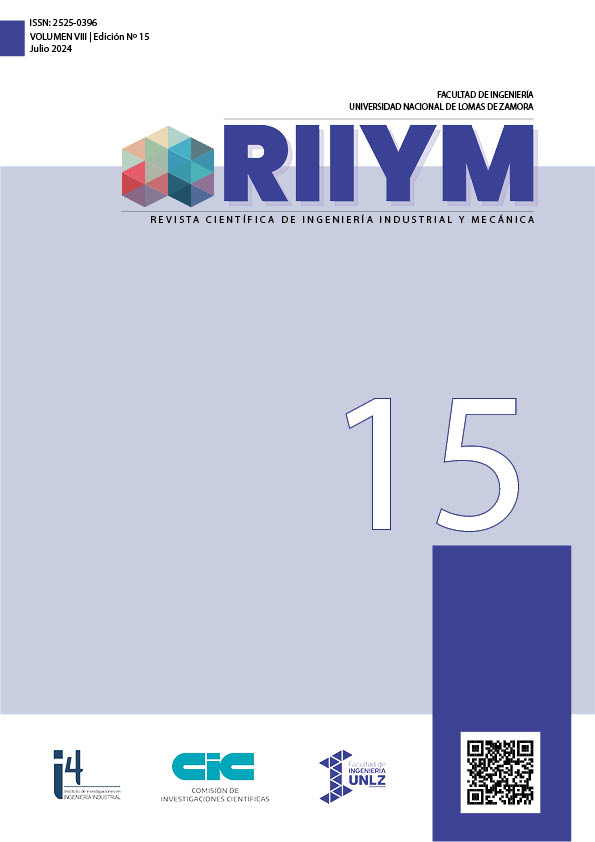SENSIBILIZACIÓN Y CORROSIÓN EN AISI 316L
Palabras clave:
Carbides, DegradationResumen
Este trabajo estudia la corrosión acelerada de acero inoxidable AISI 316L bajo exposición a una atmósfera salina durante 96h. Previamente, las muestras fueron solubilizadas a 1100°C durante 1h y luego enfriadas en agua o aire, seguidas de una sensibilización isotérmica a 650°C durante 6h. El análisis microestructural, mediante microscopía óptica y electrónica de barrido, reveló ataques severos en los bordes de grano austeníticos, atribuidos a la precipitación de distintos tipos de carburos de cromo y fases intermetálicas, como lo confirmó la difracción de rayos X. Los ensayos de corrosión indicaron que la muestra enfriada en aire presentó una mayor tasa de degradación y pérdida de masa, con un avance significativo de la corrosión intergranular, en comparación con la muestra enfriada en agua. Estos hallazgos destacan la influencia de los tratamientos térmicos sobre la susceptibilidad a la corrosión localizada
Citas
ABD RASHID, M. W., GAKIM, M., ROSLI, Z. M. y ASYADI AZAM, M. Formation of Cr23C6 during the sensitization of aisi 304 stainless steel and its effect to pitting corrosion. International Journal of Electrochemical Science. 2012, vol. 7, 9465-9477. doi: 10.1016/S1452-3981(23)16211-0.
Disponible en: https://www.sciencedirect.com/science/article/pii/S1452398123162110
AFOLABI, A. Y PELEOWO, N. Effect of heat treatment on corrosion behaviour of austenitic stainless steel in mild acid medium. Anales de International Conference on Chemical, Ecology and Environmental Sciences. 2011.
BERTUCELLI, Mariano Javier, INÉS, Mariano Nicolás, DELPUPO, María Noelia y MANSILLA, Graciela Analía. Corrosion study in sae 1016 electrogalvanized steel. XI Corrosion Latinamerican Congress, Latincorr. 2018, 031, 23- 25.
Disponible en: https://www.researchgate.net/publication/329814697_corrosion_study_in_sae_1016_electrogalvanized_steel
GRUBB, J. F., DEBOLD, T. y FRITZ, J.D. Corrosion of Wrought Stainless Steels. ASM International Handbook (tenth edition), Ohio, 2005, p. 54-77.
GILEADI, E. y KIROWA-EISNER, E. Some observations concerning the tafel equation and its relevance to charge transfer in corrosion. Corrosion Science. 2005, vol. 47, 3068-3085. doi: 10.1016/j.corsci.2005.05.044
Disponible en: https://www.sciencedirect.com/science/article/abs/pii/S0010938X05002246
KOCSISOVÁ, E., DOMÁNKOVÁ, M., SLATKOVSKÝ, I. y SAHUL, M. Study of the sensitization on the grain boundary in austenitic stainless steel aisi 316. Research paper, special number, 2014, vol. 22. Doi:10.2478/rput-2014-0019
OHTSUKA, T., UEDA, M. y ABE, M. Aging of passive oxide on SUS304 stainless steel in a sulfuric acid solution. Journal of the Electrochemical Society. 2016, vol. 163, 459-469. doi: 10.1149/2.0721608jes.
Disponible en: https://www.researchgate.net/publication/303782109_Aging_of_Passive_Oxide_on_SUS304_Stainless_Steel_in_a_Sulfuric_Acid_Solution
PADILHA, A. F., LESLEY, R. y RANGEL RIOS, P. Stainless steels heat treatment. Steel Heat Treatment Handbook (second edition), 2007, p. 695-739.
RODRÍGUEZ, C. J., FIGUEROA, Y. y PRIN, J. (2013). Efecto de la temperatura en el comportamiento del acero inoxidable Austenítico 316L frente a la corrosión electroquímica. Saber, Universidad de Venezuela, vol. 25, p. 302-308.
ISSN: 1315-0162.
SAHLAOUI, H., MAKHLOUF, K., MAKHLOUF, H. y PHILIBERT, J. Effects of aging conditions on the precipitates evolution, chromium depletion and intergranular corrosion susceptibility of aisi 316L: experimental and modeling results. Materials Science and Engineering. 2004, vol. 372, p. 98-108. doi: 10.1016/j.msea.2003.12.017.
Disponible en: https://www.sciencedirect.com/science/article/abs/pii/S0921509303014850
SCULLY, J.R. Polarization resistance method for determination of instantaneous corrosion rates. Corrosion Science. 2000, vol. 56, p. 199–218. doi: 10.5006/1.3280536.
Disponible en: https://www.researchgate.net/publication/250394524_Polarization_Resistance_Method_for_Determination_of_Instantaneous_Corrosion_Rates
SULEIMAN, I. Y., SANI, A. M. y CLIFFORD, O. O. Characterization and corrosion behaviours of aisi 316 in hydrochloric environment at various concentrations. Zastita Materijala. 2020, vol. 61, p. 220-228. doi:10.5937/zasmat2003220S.
TALHA, M., MA, Y., LIN, Y., PAN, Y., KONG, X., SINHA, O.P. y BEHERA, C.K. Corrosion performance of cold deformed austenitic stainless steels for biomedical applications. Corrosion Reviews. 2019, vol. 37, p. 283–306. doi: 10.1515/corrrev-2019-0004.
BRIANT, C.L. y HALL, E.L. Corrosion Journal. 1986, vol. 43, 522.
YANIV, A. E., LUMSDEN, J. B. y STAEHLE, R. W. The composition of passive films on ferritic stainless steels. Journal of the Electrochemical Society. 1977, vol. 124, no 4, p. 490.
SOMERVUORI, M., JOHANSSON L. S., HEINONEN, M. H., VAN HOECKE, D. H. D., AKDUT N. y HANNINEN, H. E. Characterisation and Corrosion of Spot Welds of Austenitic Stainless Steels. Materials and Corrosion. 2004, vol. 55, 6, p. 421-436.
Disponible en: https://www.researchgate.net/publication/230398147_Characterisation_and_corrosion_of_spot_welds_of_austenitic_stainless_steels
MC CARTY, K. F. y BOEHME, D. R. A Raman study of the systems Fe3−xCrxO4 and Fe2−xCrxO3. Journal of Solid State Chemistry. 1989, vol. 79, 1, p. 19-27. doi.org/10.1016/0022-4596(89)90245-4.
Disponible en: https://www.sciencedirect.com/science/article/pii/0022459689902454
GONZALES, S., COMBARMOND, L., TRAN, M. T., WOUTERS, Y. y GALERIE A. Materials Science Forum. 2008, p. 595-601.
VON MOLTKE, T., PITSORIUS P. C. y SANDENBERGH. The Influence of Heat-Tinted Surface Layers on the Corrosion Resistance of Stainless Steels. Proceedings of the 1st International Chromium Steel and Alloy Congress. 1992, vol. 2, p. 185-195.
Disponible en: https://www.pyrometallurgy.co.za/InfaconVI/2185-VonMoltke.pdf
FRANKEL, G.S. Corrosion: Fundamentals, Testing, and Protection. ASM International Handbook, 2003, vol. 13A, 236–241.
Descargas
Publicado
Cómo citar
Número
Sección
Licencia
Derechos de autor 2024 MARIANO INÉS

Esta obra está bajo una licencia internacional Creative Commons Atribución 4.0.
La propiedad intelectual de los trabajos aceptados es de sus autores, no obstante el acceso a ellos es totalmente abierto y gratuito, por lo que podrán ser reproducidos total o parcialmente con la única limitación de reconocer la autoría y la fuente de publicación.
La Revista Científica utiliza la siguiente licencia de Acceso Abierto para todos sus trabajos: CC-BY 4.0









